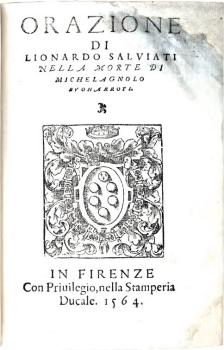At his death, Michelangelo’s cultural authority had the qualities of both a mountain and the sea, formidable and imposing yet also liquid and hard to grasp. The funeral obsequies held for Michelangelo at the church of San Lorenzo in Florence in 1564 presented a ripe opportunity to exploit the manifold potential of that authority. The pomp and splendor of Michelangelo’s funeral, princely and even imperial in scale, were unimaginable for any other visual artist in the period: Brunelleschi’s nave swathed in black cloth; a grand, freestanding catafalque with allegorical statuary at the crossing; a cycle of narrative paintings hung between the chapels, framed by gesticulating skeletons; original music; a lengthy eulogy delivered from Donatello’s pulpit; an outpouring of commemorative poems; and an elaborate pamphlet to codify the event.
That Michelangelo was mourned with the trappings usually reserved for a dead prince was neither overdetermined nor inevitable, despite his great fame. While every funeral marks a rite of passage, the obsequies for Michelangelo definitively claimed his achievement at a delicate moment of dynastic succession for the Medici regime and promoted the continued cultural vitality of the city. The ritual staged a crucial translation of the artist’s career from a body of works into a community of dominant concepts: power, time, fame, and virtue. The significance of my scholarship is twofold: to subject the permanent and ephemeral products of the funeral and its commemoration to a sustained multidisciplinary analysis on a book-length scale and to frame this unique, sprawling event within the concept of sovereignty. During my two-month residency at CASVA I worked on several chapters. The first traces the process by which arguments made for the sovereignty of the artist migrated from medieval jurisprudence to the seminal figures of Leon Battista Alberti, Niccolò Machiavelli, and Giorgio Vasari, and crystallized around Michelangelo. This chapter proposes a revisionist reading of Vasari’s 1550 biography of the artist within a comparative analysis of Machiavelli’s The Prince (1532). The second chapter turns to the specific staging of the artist’s sovereignty as a public ritual with highly charged social, spiritual, political, and intellectual dimensions. This chapter reconstructs the experience of an attendee at the requiem mass using a variety of primary sources: preparatory drawings for the cycle of narrative paintings and the catafalque; an anonymous published pamphlet of the ceremony; the notebooks and payment records for the event; surviving correspondence and contemporary descriptions; and the church archives and interior itself. What survives from the funeral is largely textual. This chapter attempts to reconstruct the sensory experience of the event by addressing it in three dimensions, as a visual, spiritual, and emotional experience coordinated to overwhelm the congregation.
The obsequies braid together two kinds of authority, political and cultural, with an insistent physicality in which Michelangelo is invoked through the presence of his works in the New Sacristy and the many linkages between his career and the Medici ruling house. The imposing catafalque functions as a hinge at San Lorenzo between the past of Brunelleschi and Donatello and the future of Bronzino and Pontormo, a history Vasari was about to rewrite. The obsequies drew on a vocabulary of concepts and visual tropes of power and eternity: fame, virtue, triumph, the subjugation of envy, the obelisk, and the orb. My book as a whole is devoted to recovering the contentiousness but also the singular intensity surrounding the first efforts to give form to Michelangelo’s value and legacy in rhetoric, poetry, history, the visual arts, and sacred ritual. The obsequies helped establish the parity of the visual arts among the liberal arts.
The second part of the book turns to close analysis of textual sources often treated dismissively: the published funeral orations of Benedetto Varchi, Giovanni Maria Tarsia, and Lionardo Salviati, all in the vernacular; the unpublished Latin oration of Francesco Bocchi; and the slim collection of poems written by Bronzino, Laura Battiferri degli Ammannati, and others. My chapters seek to reframe these texts within the spiritual tensions and cultural politics of grand-ducal Florence. I argue that these authors exercised a remarkable degree of autonomy in relation to the published biographies of Michelangelo by Vasari (1550) and Ascanio Condivi (1553). All these texts in different ways navigated their distance from the artist and cleared a space for the proliferation of a new set of Michelangelos, more detached from his corpus and his biographers. Taken together, the obsequies celebrated an ambivalent sovereign, with the capacity to provoke a reordered history of Tuscan art and to point to a wider future.
Members' Research Report Archive
Ambivalent Sovereign: Michelangelo’s Funeral at San Lorenzo
Laura Camille Agoston, Trinity University
Ailsa Mellon Bruce Visiting Senior Fellow, June 13–August 12, 2011

Lionardo Salviati, Orazione di Lionardo Salviati nella morte di Michelagnolo Buonarroti, 1564, title page. National Gallery of Art Library, Washington, David K. E. Bruce Fund
- Michelangelo
- Italian, 1475 - 1564
- Vasari, Giorgio
- Italian, 1511 - 1574